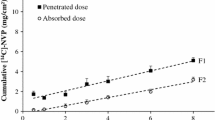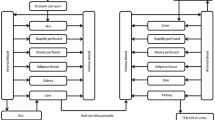Abstract
Objectives
To study the influence of the presence of water on the dermal absorption of 2-butoxyethanol (BE) in volunteers.
Methods
Six male volunteers were dermally exposed to 50%, 90% or neat w/w BE for 4 h on the volar forearm over an area of 40 cm2. An inhalation exposure with a known input rate and duration served as a reference dosage. The dermal absorption parameters were calculated from 24-h excretion of total (free + conjugated) butoxyacetic acid (BAA) in urine and BE in blood, measured after both inhalation and dermal exposure.
Results
The dermal absorption of BE from aqueous solutions was markedly higher than that of neat BE. The time-weighted average dermal fluxes were calculated from the urine and blood data and expressed in milligrammes per square centimetre per hour. The dermal fluxes obtained from cumulative 24-h excretion of BAA amounted to 1.34±0.49, 0.92±0.60 and 0.26±0.17 mg cm−2 h−1 for 50%, 90% and neat BE, respectively. The dermal fluxes calculated from the BE blood data amounted to 0.92±0.34 and 0.74±0.25 mg cm−2 h−1 for 50% and 90% BE, respectively. The permeation rates into the blood reached a plateau between 60 and 120 min after the start of exposure, indicating achievement of steady-state permeation. The apparent permeability coefficient K p , was 1.75±0.53×10−3 and 0.88±0.42×10−3 cm h−1 for 50% and 90% BE, respectively.
Conclusion
The percutaneous absorption of BE from aqueous solution increased markedly when compared with neat BE. Even water content as low as 10% led to an approximate fourfold increase in the permeation rates. These findings are important for the health risk assessment of occupational exposure to BE, since BE is commonly used in mixtures that contain water. Exposure to aqueous solutions of 50% and 90% of BE may result in substantial skin absorption: if a 60-min skin contact of 1,000 cm2 is assumed, dermal uptake would be four-times higher than the pulmonary uptake of an 8-h occupational exposure at a TLV of 100 mg m−3. This clearly justifies the skin notation for BE. For the purpose of biological monitoring, both BE in blood and BAA in urine were shown to be reliable indicators of exposure.



Similar content being viewed by others
References
Bartnik FG, Reddy AK, Klecak G, Zimmermann V, Hostynek JJ, Kunstler K (1987) Percutaneous absorption, metabolism and hemolytic activity of n-butoxyethanol. Fundam Appl Toxicol 8:59–70
Corley RA, Bormett GA, Ghanayem BI (1994) Physiologically based pharmacokinetics of 2-butoxyethanol and its major metabolite, 2-butoxyacetic acid, in rats and humans. Toxicol Appl Pharmacol 129:61–79
Corley RA, Markham DA, Banks C, Delorme P, Masterman A, Houle JM (1997) Physiologically based pharmacokinetics and the dermal absorption of 2-butoxyethanol vapor by humans. Fundam Appl Toxicol 39:120–130
Dugard PH, Walker M, Mawdsley SJ, Scott RC (1984) Absorption of some glycol ethers through human skin in vitro. Environ Health Perspect 57:193–197
Johanson G, Fernstrom P (1986) Percutaneous uptake rate of 2-butoxyethanol in the guinea pig. Scand J Work Environ Health 12:499–503
Johanson G, Fernstrom P (1988) Influence of water on the percutaneous absorption of 2-butoxyethanol in guinea pigs. Scand J Work Environ Health 14:95–100
Johanson G, Boman A (1991) Percutaneous absorption of 2-butoxyethanol vapor in human subjects. Br J Ind Med 48:788–792
Johanson G, Kronborg H, Naslund PH, Byfalt NM (1986) Toxicokinetics of inhaled 2-butoxyethanol (ethylene glycol monobutyl ether) in man. Scand J Work Environ Health 12:594–602
Johanson G, Boman A, Dynesius B (1988) Percutaneous absorption of 2-butoxyethanol in man. Scand J Work Environ Health 14:101–109
Meuling WJ, Franssen AC, Brouwer DH, van Hemmen JJ (1997) The influence of skin moisture on the dermal absorption of propoxur in human volunteers: a consideration for biological monitoring practices. Sci Total Environ 199:165–172
Ministerie van sociale zaken en werkgelegenheid (2001) Nationale MAC-lijst 2001. SDU, Den Haag, p 19
Opdam JJG (1989) The respiratory input in inhalation experiments. Br J Ind Med 46:145–156
Opdam JJ (1991) Linear systems dynamics in toxicokinetics studies. Ann Occup Hyg 35:633–649
Rettenmeier AW, Hennigs R, Wodarz R (1993) Determination of butoxyacetic acid and N-butoxyacetyl-glutamine in urine of lacquerers exposed to 2-butoxyethanol. Int Arch Occup Environ Health 65:S151–153
Sakai T, Araki T, Morita Y, Masuyama Y (1994) Gas chromatographic determination of butoxyacetic acid after hydrolysis of conjugated metabolites in urine from workers exposed to 2-butoxyethanol. Int Arch Occup Environ Health 66:249–254
Scheuplein RJ, Blank IH (1973) Mechanism of percutaneous absorption. IV. Penetration of nonelectrolytes (alcohols) from aqueous solutions and from pure liquids. J Invest Dermatol 60:286–296
Tang H, Blankschtein D, Langer R (2002) Prediction of steady-state skin permeabilities of polar and nonpolar permeants across excised pig skin based on measurements of transient diffusion: characterization of hydration effects on the skin porous pathway. J Pharm Sci 91:1891–1907
Tezel A, Sens A, Mitragotri S (2003) Description of transdermal transport of hydrophilic solutes during low-frequency sonophoresis based on a modified porous pathway model. J Pharm Sci 92:381–393
Vincent R, Rieger B, Subra I, Poirot P (1996) Exposure assessment to glycol ethers by atmosphere and biological monitoring. Occup Hyg 2:79–90
Wilkinson SC, Williams FM (2002) Effects of experimental conditions on absorption of glycol ethers through human skin in vitro. Int Arch Occup Environ Health 75:519–527
Acknowledgments
We are grateful to M.M. Verberk, PhD, and A.C. Monster, PhD, for their valuable discussion and criticism of the manuscript, and to Ms F. Calkoen, MSc, for technical assistance. The authors would like to thank the European Community for the financial support of this study, which was performed within the Fifth Framework Programme (project acronym: EDETOX).
Author information
Authors and Affiliations
Rights and permissions
About this article
Cite this article
Jakasa, I., Mohammadi, N., Krüse, J. et al. Percutaneous absorption of neat and aqueous solutions of 2-butoxyethanol in volunteers. Int Arch Occup Environ Health 77, 79–84 (2004). https://doi.org/10.1007/s00420-003-0456-3
Received:
Accepted:
Published:
Issue Date:
DOI: https://doi.org/10.1007/s00420-003-0456-3




